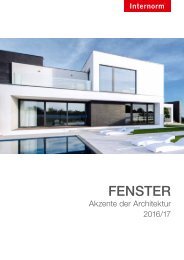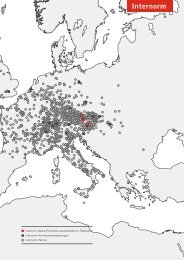FENSTERBUCH_2016_UK
Create successful ePaper yourself
Turn your PDF publications into a flip-book with our unique Google optimized e-Paper software.
THERMAL INSULATION & SOUND REDUCTION<br />
Dobratsch summit house 2,143 m, Transform Architekten ZT-GmbH, Architekt DI Günter Weratschnig<br />
THERMAL INSULATION<br />
ENERGY EFFICIENT. PLEASANT. WARM.<br />
SOUND REDUCTION<br />
CALM. COZY. QUIET.<br />
Highly thermally insulating window systems ensure<br />
homeliness and warmth in your own four walls. In<br />
connection with a special coating for using solar<br />
radiation they virtually become your free-of-charge<br />
additional heating.<br />
As a building can lose approximately 25 to 30 % of its<br />
energy through the windows, the thermal insulation of the<br />
windows is especially important. Through careful planning,<br />
correct positioning of the window areas (large window areas<br />
south-facing) can positively infl uence the energy balance of<br />
the building. The thermal insulation of the window depends<br />
on the frame material, the insulating glass and the tightness<br />
of the window. The parameter for the insulating<br />
capability of the window is the U value. The lower the<br />
value, the better the thermal insulation. Additional<br />
features such as roller shutters and window shutters can<br />
improve the U value.<br />
Outside walls<br />
25 – 30 %<br />
Roof or top ceiling<br />
25 – 30 %<br />
Basement ceiling<br />
10 – 20 %<br />
Possible overall heat losses of a badly insulated building<br />
Windows<br />
25 – 30 %<br />
Interference of noise is unpleasant and can, given the right<br />
intensity and duration, affect the human body negatively.<br />
Noise is perceived through the human ear and passed on<br />
to the brain.<br />
Sound reduction of a window is measured in decibels. The<br />
higher the value, the better the sound reduction. Sound<br />
reduction states how much sound energy from the original<br />
sound energy is allowed to pass through. At an insulation<br />
of 10 dB 1/10 of the original sound energy passes through,<br />
at 20 dB 1/100, at 30 dB 1/1000 etc. Humans perceive a<br />
reduction of 10 dB as halving the noise. Sound reduction<br />
of a window is dependent on frame material, insulating<br />
glass, tightness of the window and the construction<br />
connection.<br />
VOLUME NOISE EFFECT TYPE OF SOUND<br />
10 dB<br />
Pin dropping<br />
very quiet<br />
20 dB Leaves rustling, clock<br />
30 dB<br />
Whispering<br />
40 dB quiet Quiet talking<br />
50 dB Residential street, birds<br />
60 dB<br />
Talking, radio<br />
loud<br />
70 dB Loud talking, street<br />
80 dB<br />
Heavy traffi c<br />
very loud<br />
90 dB Shouting, hooting<br />
100 dB<br />
Circular saw<br />
110 dB Pneumatic hammer<br />
unbearable<br />
120 dB Jet plane<br />
> 150 dB Explosion, rocket<br />
64 I 65




